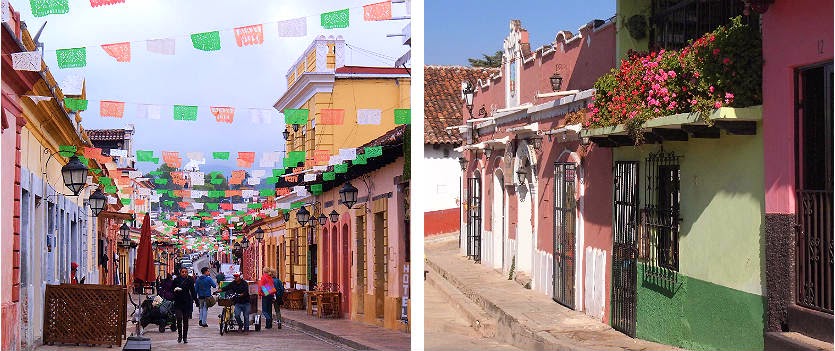This year we spent a month on the beach in San Agustinillo, with a side-trip into the mountains of Oaxaca. Then we stayed for a week in San Cristobal de las Casas, Chiapas. From there, we made our first visit to Guatemala. We liked it so well that we'll visit a different part of Guatemala in 2016.
First, more photos from San Agustinillo, our favorite haunt on the Pacific coast of Oaxaca, Mexico.
 |
| San Agustinillo village, with newly paved road, and the view from our balcony at Posada la Barca |
 |
| The beach in mid-morning |
 |
| Even better, another dawn on the beach |
 |
| In the morning we walk around a point to reach a secluded beach. When the surf is up, it can look intimidating, but we've always made it. |
Often we walk to Punta Cometa, about 40 minutes away, the southernmost point in Oaxaca. It's a popular place to watch the sun set over the ocean.
 |
| Punta Cometa at sunset |
Pluma Hidalgo
It can be really hot in Oaxaca, even on the beach. We took a short break to cool off by visiting Pluma Hidalgo, a town in the mountains known for coffee production. We were there only two nights, staying in two different hotels and hiking in the nearby countryside.
 |
| Waiting for a camioneta -- a little truck that carries passengers. Getting to Pluma Hidalgo in the mountains can involve a lot of waiting! |
 |
| On the first night in Pluma, sunset from the balcony of our room in the village |
 |
| The trouble with walking around Pluma is that there are no level places! |
 |
| Sunset basketball; Pluma Hidalgo side street |
 |
| Village square; with a schoolgirl whose parents wanted her to practice English with us |
 |
| Finca Don Gabriel, a coffee plantation and tourist lodging a few kilometers from Pluma, where we stayed the second night |
 |
| Back from a hike and resting on our terrace at Finca Don Gabriel |
Back to the Beach
Even though we liked Pluma Hidalgo very much, we were glad to return to the beach. During our last week there, we saw something we'd never seen before -- local daredevils (or lunatics) jumping from the offshore rocks.
 |
| We won't be trying this anytime soon. |
In San Agustinillo we've usually stayed at Posada la Barca. We like it very well. However we decided to make a change for next year, 2016, because we want a full kitchen and a little more privacy and space. We've already booked a new cabana at the other end of the beach.
 |
| Our cabana next year is at the far end of the main beach. It's third up from the beach, in the center of this photo. |
After our month at San Agustinillo, we boarded an overnight bus from Pochutla to San Cristobal de las Casas, Chiapas. It's a wonderful town.



































